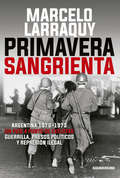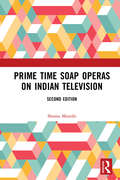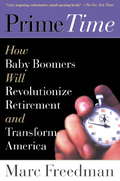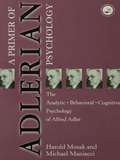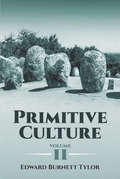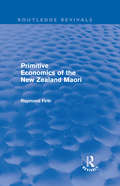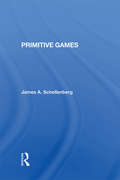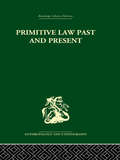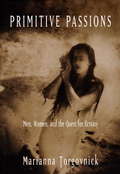- Table View
- List View
Primates of Park Avenue: A Memoir
by Wednesday MartinLike an urban Dian Fossey, Wednesday Martin decodes the primate social behaviors of Upper East Side mothers in a brilliantly original and witty memoir about her adventures assimilating into that most secretive and elite tribe.After marrying a man from the Upper East Side and moving to the neighborhood, Wednesday Martin struggled to fit in. Drawing on her background in anthropology and primatology, she tried looking at her new world through that lens, and suddenly things fell into place. She understood the other mothers' snobbiness at school drop-off when she compared them to olive baboons. Her obsessional quest for a Hermes Birkin handbag made sense when she realized other females wielded them to establish dominance in their troop. And so she analyzed tribal migration patterns; display rituals; physical adornment, mutilation, and mating practices; extra-pair copulation; and more. Her conclusions are smart, thought-provoking, and hilariously unexpected. Every city has its Upper East Side, and in Wednesday's memoir, readers everywhere will recognize the strange cultural codes of powerful social hierarchies and the compelling desire to climb them. They will also see that Upper East Side mothers want the same things for their children that all mothers want--safety, happiness, and success--and not even sky-high penthouses and chauffeured SUVs can protect this ecologically released tribe from the universal experiences of anxiety and loss. When Wednesday's life turns upside down, she learns how deep the bonds of female friendship really are. Intelligent, funny, and heartfelt, Primates of Park Avenue lifts a veil on a secret, elite world within a world--the exotic, fascinating, and strangely familiar culture of privileged Manhattan motherhood.
Primates, Pathogens, and Evolution
by Kate Pechenkina Jessica F. BrinkworthThe immune systems of human and non-human primates have diverged over time, such that some species differ considerably in their susceptibility, symptoms, and survival of particular infectious diseases. Variation in primate immunity is such that major human pathogens - such as immunodeficiency viruses, herpesviruses and malaria-inducing species of Plasmodium - elicit striking differences in immune response between closely related species and within primate populations. These differences in immunity are the outcome of complex evolutionary processes that include interactions between the host, its pathogens and symbiont/commensal organisms. The success of some pathogens in establishing persistent infections in humans and other primates has been determined not just by the molecular evolution of the pathogen and its interactions with the host, but also by the evolution of primate behavior and ecology, microflora, immune factors and the evolution of other biological systems. To explore how interactions between primates and their pathogens has shaped their mutual molecular evolution, Primates, Pathogens and Evolution brings together research that explores comparative primate immune function, the emergence of major and neglected primate diseases, primate-microorganism molecular interactions, and related topics. This book will be of interest to anyone curious as to why infectious diseases manifest differently in humans and their closest relatives. It will be of particular interest to scholars specializing in human and non-human primate evolution, epidemiology and immunology, and disease ecology. Primates, Pathogens and Evolution offers an overview and discussion of current findings on differences in the molecular mechanics of primate immune response, as well as on pathogen-mediated primate evolution and human and non-human primate health.
Primates: An Introduction
by Alfred L. RosenbergerThis book is an accessible and comprehensive introduction to primates. It provides both a survey and synthesis of primate history, biology, and behavior. As a survey, it offers a focused review of living and extinct primates in regional and community frameworks. As a synthesis, it applies the community perspective in a unique way to explore primates’ adaptive diversity in the context of how evolution works. The book encourages students to study primates as integrated members of regional communities, ecologically, historically, and evolutionarily. The chapters are organized to emphasize the patterns of primate radiations in the four regions of the world where primates live, and to facilitate comparisons among the radiations. The overviews of communities illustrate how the ecological adaptations of different species and taxonomic or phylogenetic groups enable them to coexist. Illustrations and tools to aid students’ learning include case studies, photographs, figures, tables, charts, key concepts, and quizlets to self-test. This book is an ideal introduction for students studying nonhuman primates, primatology, primate behavior, or primate ecology.
Primavera sangrienta: Argentina 1970-1973 un país a punto de explotar. Guerrila, presos políticos y represión ilegal
by Marcelo LarraquyEsta es la crónica del nacimiento y crecimiento de la guerrilla a comienzos de los setenta, y de un día feliz: el 25 de mayo de 1973, cuando asume Cámpora y cuando los presos políticos por las primeras acciones armadas salen en libertad gracias a la presión popular y a un indulto que no había firmado... ¡nadie! El 25 de mayo de 1973, el mismo día en que Cámpora asumía la Presidencia en la Casa Rosada, miles de manifestantes exigían la libertad de los presos políticos. La presión popular extendida a todo el país fue tan fuerte que las rejas se abrieron esa misma noche, que pasó a la historia como "el Devotazo". En esas horas únicas, cargadas de tensión, Marcelo Larraquy registra voces calladas hasta ahora, que relatan de primerísima mano las tácticas de la guerrilla para enfrentar a una dictadura militar en retroceso, con juicios sumarios como el del general Aramburu, secuestros a empresarios, tomas de poblaciones, robos de camiones de caudales y fugas audaces como la de Trelew, que terminaría en una masacre en la base naval. A partir de testimonios inaccesibles hasta hoy y nuevas fuentes documentales, Larraquy logra componer el retrato de una época que dejará sin respiro al lector, con una sucesión de acontecimientos que encaminarían al país hacia su década más feroz y espeluznante.
Prime Time Animation: Television Animation and American Culture
by Carol StabileIn September 1960 a television show emerged from the mists of prehistoric time to take its place as the mother of all animated sitcoms. The Flintstones spawned dozens of imitations, just as, two decades later, The Simpsons sparked a renaissance of primetime animation. This fascinating book explores the landscape of television animation, from Bedrock to Springfield, and beyond.The contributors critically examine the key issues and questions, including: How do we explain the animation explosion of the 1960s? Why did it take nearly twenty years following the cancellation of The Flintstones for animation to find its feet again as primetime fare? In addressing these questions, as well as many others, essays examine the relation between earlier, made-for-cinema animated production (such as the Warner Looney Toons shorts) and television-based animation; the role of animation in the economies of broadcast and cable television; and the links between animation production and brand image. Contributors also examine specific programmes like The Powerpuff Girls, Daria, Ren and Stimpy and South Park from the perspective of fans, exploring fan cybercommunities, investigating how ideas of 'class' and 'taste' apply to recent TV animation, and addressing themes such as irony, alienation, and representations of the family.
Prime Time Soap Operas on Indian Television
by Shoma MunshiThis book focuses on ‘urban family soaps’ on television and analyses them as an important resource for anthropological insights into contemporary social issues and practices. It studies the ‘popular’ and ‘everyday’ while also concentrating on the middle class.
Prime Time Soap Operas on Indian Television
by Shoma MunshiThis book examines the phenomenon of prime time soap operas on Indian television. An anthropological insight into social issues and practices of contemporary India through the television, this volume analyzes the production of soaps within India’s cultural fabric. It deconstructs themes and issues surrounding the "everyday" and the "middle class" through the fiction of the "popular". In its second edition, this still remains the only book to examine prime time soap operas on Indian television. Without in any way changing the central arguments of the first edition, it adds an essential introductory chapter tracking the tectonic shifts in the Indian "mediascape" over the past decade – including how the explosion of regional language channels and an era of multiple screens have changed soap viewing forever. Meticulously researched and persuasively argued, the book traces how prime time soaps in India still grab the maximum eyeballs and remain the biggest earners for TV channels. The book will be of interest to students of anthropology and sociology, media and cultural studies, visual culture studies, gender and family studies, and also Asian studies in general. It is also an important resource for media producers, both in content production and television channels, as well as for the general reader.
Prime Time: A History of the Middle Aged in Twentieth-Century Britain
by John BensonNumerous studies consider the history of childhood, adolescence and old age, yet the middle aged, consistently the most productive and powerful of age groups have been consistently ignored. In this pioneering study John Benson considers how perceptions and experience of middle age have changed, and how its power-base has diminished, affected by the steady ageing of the population the increasing independence of the yound and growing economic insecurity. This thought-provoking study also illuminates the whole economic, social and cultural history of twentieth-century Britain.
Prime Time: How Baby Boomers Will Revolutionize Retirement And Transform America
by Marc FreedmanOver the next three decades, the number of Americans over fifty will double, swelling to more than a quarter of the population. Already we are living thirty years longer than a century ago, with further gains expected in the coming years. The end result is a new stage of life, one as long or longer than childhood or middle age in duration, and one spent in unprecedented good health. Yet, as individuals, and as a society, we've shown little imagination or wisdom in using this great gift of a third age. Marc Freedman identifies the new longevity as not a problem to be solved, but an opportunity to be seized-provided we can engage the experience, talent, and idealism of older Americans. At a juncture when the middle-generation faces a time-famine, struggling to simultaneously raise kids and work long hours on the job, the older generation is awash in free time, poised to succeed women as the trustees of civic life in this country. In the process they stand to find new meaning and purpose in their lives, and abandon the limbo-like state unfulfilling for so many older individuals. Freedman argues that the aging phenomenon, the massive transformation that many portray as our downfall, may in fact be our best hope for renewal as a nation.
Prime-Time Society: An Anthropological Analysis of Television and Culture, Updated Edition
by Conrad Phillip KottakA landmark comparative study (U.S. and Brazil) of television's social and cultural effects on human behavior. The Updated Edition brings forward the author’s research on this topic since the original volume was published in 1990 with an extensive new Introduction.
Primer for Critiquing Social Research: A Student Guide
by Michael J. HoloskoCritique social research with ease with Primer for Critiquing Social Research: A Student Guide! In a simple, hands-on manner, this text helps you develop the analytical tools and critical thinking skills you need to successfully critique social research. Critiquing is made easy with a book-specific website which offers frequently asked questions, an evaluation template, and other information about the text and its use.
Primer of Adlerian Psychology: The Analytic - Behavioural - Cognitive Psychology of Alfred Adler
by Harold Mosak Michael ManiacciA Primer of Adlerian Psychology offers an accessible, yet very learned, introduction to Adlerian Psychology. Also known as Individual Psychology, the approach stresses the unity of the individual, the subjective choices he or she makes and the goals the individual works towards he or she moves through life. Therapists can apply this theory in a variety of settings with populations of all ages, making it a highly practical and valuable approach. Written by two scholars with extensive knowledge and experience in this school of thought, this book covers the basic tenets of Individual Psychology geared toward those students and clinicians who are yet unfamiliar with Adler's work.
Primetime Blues: African Americans on Network Television
by Donald BogleA landmark study by the leading critic of African American film and televisionPrimetime Blues is the first comprehensive history of African Americans on network television. Donald Bogle examines the stereotypes, which too often continue to march across the screen today, but also shows the ways in which television has been invigorated by extraordinary black performers, whose presence on the screen has been of great significance to the African American community. Bogle's exhaustive study moves from the postwar era of Beulah and Amos 'n' Andy to the politically restless sixties reflected in I Spy and an edgy, ultra-hip program like Mod Squad. He examines the television of the seventies, when a nation still caught up in Vietnam and Watergate retreated into the ethnic humor of Sanford and Son and Good Times and the poltically conservative eighties marked by the unexpected success of The Cosby Show and the emergence of deracialized characters on such dramatic series as L.A. Law. Finally, he turns a critical eye to the television landscape of the nineties, with shows such as The Fresh Prince of Bel Air, I'll Fly Away, ER, and The Steve Harvey Show.Note: The ebook edition does not include photos.
Primeval Kinship: How Pair-bonding Gave Birth To Human Society
by Bernard ChapaisIn this account of the dawn of human society, Bernard Chapais shows that our knowledge about kinship and society in nonhuman primates supports, and informs, ideas first put forward by the distinguished social anthropologist, Claude Levi-Strauss. Chapais contends that only a few evolutionary steps were required to bridge the gap between the kinship structures of our closest relatives-chimpanzees and bonobos-and the human kinship configuration. The pivotal event, the author proposes, was the evolution of sexual alliances. Pair-bonding transformed a social organization loosely based on kinship into one exhibiting the strong hold of kinship and affinity. The implication is that the gap between chimpanzee societies and pre-linguistic hominid societies is narrower than we might think. Primeval Kinship suggests that the study of kinship and social organization can provide a link between social and biological anthropology.
Primitive Characters of Liangzhu: Paintings and Symbols (Liangzhu Civilization)
by Yong Xia Xuefei ZhuThis book mainly focuses on the roles of engraved symbols and ornamentation in Liangzhu culture. It categorizes the engraved symbols discovered in Liangzhu culture as means of ideographical expression and decoration, aspects that are explored in detail. Further, the engraved symbols and ornamentation are subdivided in terms of certain similarities, including the dragon and bird systems. A separate chapter is especially designed to help readers appreciate the typical paintings and symbols in selected objects and vessels. In this way, the book seeks to analyze and generate a particular formula so as to explore patterns in the thinking of Liangzhu’s people, thus deciphering the spiritual code of the Liangzhu world.
Primitive Classification (Routledge Revivals: Emile Durkheim: Selected Writings in Social Theory)
by Emile Durkheim Marcel MaussIn this influential work, first published in English in 1963, Durkheim and Mauss claim that the individual mind is capable of classification and they seek the origin of the ‘classificatory function’ in society. On the basis of an intensive examination of forms and principles of symbolic classification reported from the Australian aborigines, the Zuñi and traditional China, they try to establish a formal correspondence between social and symbolic classification. From this they argue that the mode of classification is determined by the form of society and that the notions of space, time, hierarchy, number, class and other such cognitive categories are products of society. Dr Needham’s introduction assesses the validity of Durkhiem and Mauss’s argument, traces its continued influence in various disciplines, and indicates its analytical value for future researches in social anthropology.
Primitive Culture Volume I
by Edward Burnett TylorUse of the term "culture" as an expression of the full range of learned human behavior patterns began with this classic two-volume work, first published in 1871. Edward B. Tylor, the first Professor of Anthropology at the University of Oxford, declared that culture is "that complex whole which includes knowledge, belief, art, law, morals, custom, and any other capabilities and habits acquired by man as a member of society." Tylor is credited with the establishment of anthropology as a scientific discipline, and his groundbreaking work was highly influential in the development of cultural evolution as the foundation for anthropologic studies. Tylor's unilinear model of development maintains that humans share a common history, evolving from a single primitive form. His studies of the languages, rituals, and beliefs of societies from around the world pioneered the use of statistical data and substantiated his view of a universal pattern of development in all cultures. Volume I of Primitive Culture focuses on social evolution, language, and myth. Volume II focuses on Tylor's interpretation of animism in society, offering details of the endlessly varied ideas and beliefs regarding the soul, spirits, and gods.
Primitive Culture, Volume II: Researches Into The Development Of Mythology, Philosophy, Religion, Art, And Custom, Volume 2 - Primary Source Edition (Cambridge Library Collection - Anthropology)
by Edward Burnett TylorThe first Professor of Anthropology at the University of Oxford, Edward B. Tylor, defined the term "culture" for modern readers in this groundbreaking work. Initially published in 1871, this classic two-volume study explores the full range of learned human behavior patterns in terms of the beliefs, wisdom, laws, artistic achievements, and mores that constitute a society. The formation of anthropology as a scientific discipline began with this work, which continues to exercise a profound influence on anthropologic studies. The shared history of all humans, a common ground that evolved from primitive roots, constitutes the basis for Tylor's model of development. Drawing upon a worldwide variety of beliefs, rituals, and languages, the author illustrates an all-inclusive pattern of progress. His methods inaugurated the use of statistical data in anthropology, a standard procedure today but a landmark for his time. Volume I of Primitive Culture examines social evolution, language, and myth. The focus of this second volume is animism in society, which explores the tremendous diversity of thinking related to the concepts of the soul and religion as well as the marked similarities of spiritual beliefs.
Primitive Economics of the New Zealand Maori (Routledge Revivals)
by Raymond FirthFirst published in 1929, Raymond Firth’s original and insightful study offers an incredibly detailed account of the social and economic organisation of the Maori people before their contact with Western civilisation. Bridging the gap between anthropology and economics, the work covers the class structure, land system, industry, methods of co-operative labour, exchange and distribution, and the psychological foundations of Maori society. This reissue will be welcomed by all students of anthropology and anyone interested the history of the Maori people.
Primitive Games
by James A SchellenbergThis book shows how primitive games relate to the broader framework of the theory of games and provides a general discussion of the different types of primitive games. It deals with applications of primitive games to particular areas of social research.
Primitive Labour (Routledge Revivals)
by L.H. Dudley BuxtonOriginally published in 1924, Dudley Buxton explores the evolution of primitive societies in relation to labour. This is mostly done by studying primitive inventions to try and understand how each of these inventions was used to contribute to everyday living and to develop the society’s material culture. This study places an emphasis on understanding the importance of various industrial tools to societies in relation to different industries and geographical factors such as climate. This title will be of interest to students of Anthropology.
Primitive Law, Past and Present
by A.S. DiamondThis book is a study of the beginnings of law and the 'primitive' stages of its development, from the first rudimentary rules of conduct to the codes of the legal systems. Its scope extends to both cultures and legal systems from the ancient and medieval past: those of the Babylonians and Assyrians, Hittites, Hebrews, Romans, Hindus, English and other German peoples, and those of Africa, Australia and America. Correlating early economic and legal development, the book illustrates how laws change with the development of material culture. Originally published in 1971.
Primitive Man as Philosopher
by Paul Radin John Dewey Neni PanourgiaAnthropology is a science whose most significant discoveries have come when it has taken its bearings from literature, and what makes Paul Radin’s Primitive Man as Philosopher a seminal piece of anthropological inquiry is that it is also a book of enduring wonder. Writing in the 1920s, when anthropology was still young, Radin set out to show that “primitive” cultures are as intellectually sophisticated and venturesome as any of their “civilized” counterparts. The basic questions about the structure of the natural world, the nature of right and wrong, and the meaning of life and death, as well as basic methods of considering the truth or falsehood of the answers those questions give rise to, are, Radin argues, recognizably consistent across the whole range of human societies. He rejects both the romantic myth of the noble savage and the rationalist dismissal of the primitive mind as essentially undeveloped, averring that the anthropologist and the anthropologist’s subject meet on the same philosophical ground, and only when that is acknowledged can anthropology begin in earnest. The argument is clearly and forcibly made in pages that also contain an extraordinary collection of poems, proverbs, myths, and tales from a host of different cultures, making Primitive Man as Philosopher not only a lasting contribution to the discipline of anthropology but a unique, rich, and fascinating anthology, one that both illuminates and enlarges our imagination of the human.
Primitive Normativity: Race, Sexuality, and Temporality in Colonial Kenya
by Elizabeth W. WilliamsIn Primitive Normativity Elizabeth W. Williams traces the genealogy of a distinct narrative about African sexuality that British colonial authorities in Kenya used to justify their control over indigenous populations. She identifies a discourse of “primitive normativity” that suggested that Africans were too close to nature to develop sexual neuroses and practices such as hysteria, homosexuality, and prostitution which supposedly were common among Europeans. Primitive normativity framed Kenyan African sexuality as less polluted than that of the more deviant populations of their colonizers. Williams shows that colonial officials and settlers used this narrative to further the goals of white supremacy by arguing that Africans’ sexuality was proof that Kenyan Africans must be protected from the forces of urbanization, Western-style education, and political participation, lest they be exposed to forms of civilized sexual deviance. Challenging the more familiar notion that Europeans universally viewed Africans as hypersexualized, Williams demonstrates how narratives of African sexual normativity rather than deviance reinforced ideas about the evolutionary backwardness of African peoples and their inability to govern themselves.
Primitive Passions
by Marianna TorgovnickBeginning with early 20th-century figures--among them Carl Jung, Isak Dinesen, and Georgia O'Keeffe--who found in "the primitive" a medium for soul-searching and personal change, Torgovnivk probes how the return to the primitive has signaled a quest to transcend the limitations of the body in a variety of contemporary practices, from genital piercing to New Age rites to the mythopoetic men's movement. Illustrations. 272 pp. Author tour. 10,000 print.



